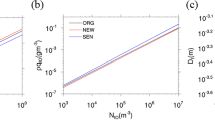Summary
Seven different microphysical sensitivity experiments were designed with an objective to evaluate their respective impacts in modulating hurricane intensity forecasts using mesoscale model MM5. Microphysical processes such as melting of graupel, snow and cloud ice hydrometeors, suppression of evaporation of falling rain, the intercept parameter and fall speed of snow and graupel hydrometeors are modified in the existing NASA Goddard Space Flight Center (GSFC) microphysical parameterization scheme. We studied the impacts of cloud microphysical processes by means of track, intensity, precipitation, propagation speed, kinematic and thermodynamic vertical structural characteristics of hurricane inner core. These results suggest that the set of experiments where (a) melting of snow, graupel and cloud ice were suppressed (b) melting of snow and graupel were suppressed and (c) where the evaporation of rain water was suppressed all produced most intense storms. The major findings of this study are the interconversion processes such as melting and evaporation among hydrometeors and associated feedback mechanism are significantly modulate the intensity of the hurricane. In particular an experiment where the melting of graupel, snow and cloud ice hydrometeors was eliminated from the model parameterization scheme produced the most explosively intensified storm. In the experiment where rain water evaporation was eliminated from the model, it produced a stronger storm as compared to the control run but it was not as strong as the storms produced from absence of melting processes. The impact on intensity due to variations made in intercept parameters of the hydrometeors (i.e., snow and graupel) were not that evident compared to other experiments. The weakest storm was noted in the experiment where the fall speeds of the snow hydrometeors were increased two fold. This study has isolated some of the factors that contributed to a stronger hurricane and concludes with a motivation that the findings from this study will help in further improvement in the design of sophisticated explicit microphysical parameterization for the mesoscale non-hydrostatic model for realistic hurricane intensity forecasts.
Similar content being viewed by others
References
SA Braun (2002) ArticleTitleA cloud-resolving simulation of hurricane Bob (1991): Storm structure and eyewall buoyancy Mon Wea Rev 130 1573–1592 Occurrence Handle10.1175/1520-0493(2002)130<1573:ACRSOH>2.0.CO;2
SA Braun W-K Tao (2000) ArticleTitleSensitivity of high-resolution simulations of hurricane Bob (1991) to planetary boundary layer parameterizations Mon Wea Rev 128 3941–3961 Occurrence Handle10.1175/1520-0493(2000)129<3941:SOHRSO>2.0.CO;2
MS Gilmore JM Straka EN Rasmussen (2004) ArticleTitlePrecipitation and evolution sensitivity in simulated deep convective storms: comparisons between liquid-only and simple ice and liquid phase microphysics Mon Wea Rev 132 1897–1916 Occurrence Handle10.1175/1520-0493(2004)132<1897:PAESIS>2.0.CO;2
HF Hawkins SM Imbembo (1976) ArticleTitleThe structure of a small, intense hurricane Inez 1966 Mon Wea Rev 104 418–442 Occurrence Handle10.1175/1520-0493(1976)104<0418:TSOASI>2.0.CO;2
Huffman GJ, Adler RF, Stocker EF, Bolvin DT, Nelkin EJ (2003) Analysis of TRMM 3-hourly multi-satellite precipitation estimates computed in both real and post-real time. Preprints, 12th Conf. on Satellite Meteorology and Oceanography, Long Beach, CA. Amer Meteor Soc, 6 pp
Kessler E (1969) One the distribution and continuity of water substance in atmospheric circulations. Meteor Monogr, vol. 32: Amer Meteor Soc, 84 pp
Y Liu D-L Zhang MK Yau (1997) ArticleTitleA multiscale numerical study of hurricane Andrew (1992). Part 1: Explicit simulation and verification Mon Wea Rev 125 3073–3093 Occurrence Handle10.1175/1520-0493(1997)125<3073:AMNSOH>2.0.CO;2
Y Liu D-L Zhang MK Yau (1999) ArticleTitleA multiscale numerical study of hurricane Andrew (1992). Part 2: Kinematics and inner-core structures Mon Wea Rev 127 2597–2620 Occurrence Handle10.1175/1520-0493(1999)127<2597:AMNSOH>2.0.CO;2
Y-L Lin RD Farley HD Orville (1983) ArticleTitleBulk parameterization of the snow field in a cloud model J Climate Appl Meteor 22 1065–1092 Occurrence Handle10.1175/1520-0450(1983)022<1065:BPOTSF>2.0.CO;2
SJ Lord JM Lord (1988) ArticleTitleVertical velocity structure in an axisymmetric, nonhydrostatic tropical cyclone model J Atmos Sci 45 1453–1461 Occurrence Handle10.1175/1520-0469(1988)045<1453:VVSIAA>2.0.CO;2
SJ Lord HE Willoughby JM Piotrowicz (1984) ArticleTitleRole of a parameterized ice-phase microphysics in an axisymmetric, nonhydrostatic tropical cyclone model J Atmos Sci 41 2836–2848 Occurrence Handle10.1175/1520-0469(1984)041<2836:ROAPIP>2.0.CO;2
JS Marshall WM Palmer (1948) ArticleTitleThe distribution of raindrops with size J Meteorol 5 165–166
GM McFarquhar RA Black (2004) ArticleTitleObservations of particle size and phase in tropical cyclones: implications for mesoscale modeling of microphysical processes J Atmos Sci 61 422–439 Occurrence Handle10.1175/1520-0469(2004)061<0422:OOPSAP>2.0.CO;2
S Pattnaik TN Krishnamurti (2007) ArticleTitleImpact of cloud microphysical process on hurricane intensity. Part 1: Control run Meteorol Atmos Phys 97 117–125 Occurrence Handle10.1007/s00703-006-0247-y
Rogers R, Black R, Black M (2005) Evaluating microphysical parameterization schemes for use in hurricane environments. J Atmos Sci CAMEX-4 (special issue, submitted)
SA Rutledge PV Hobbs (1984) ArticleTitleThe mesoscale and microscale organization of clouds and precipitation in midlatitude cyclones. 12: A diagnostic modeling study of precipitation development in narrow cold-frontal rainbands J Atmos Sci 41 2949–2972 Occurrence Handle10.1175/1520-0469(1984)041<2949:TMAMSA>2.0.CO;2
WK Tao J Simpson (1993) ArticleTitleGoddard cumulus ensemble model. Part 1: Model description Terr Atmos Ocean Sci 4 35–72
WK Tao J Simpson M McCumber (1989) ArticleTitleAn ice–water saturation adjustment Mon Wea Rev 117 231–235 Occurrence Handle10.1175/1520-0493(1989)117<0231:AIWSA>2.0.CO;2
Wang Y (1999) A triply nested movable mesh tropical cyclone model – TCM3. BMRC Research Rep 74, 81 pp [Available from Bureau of Meteorology Research Centre, Melbourne, Victoria 3001, Australia.]
Y Wang (2001) ArticleTitleAn explicit simulation of tropical cyclones with a triply nested movable mesh primitive equation model – TCM3. Part 1: Description of the model and control experiment Mon Wea Rev 129 1270–1294
Y Wang (2002) ArticleTitleAn explicit simulation of tropical cyclones with a triply nested movable mesh primitive equation model: TCM3. Part 2: Model refinements and sensitivity to cloud microphysics parameterization Mon Wea Rev 130 3022–3036 Occurrence Handle10.1175/1520-0493(2002)130<3022:AESOTC>2.0.CO;2
Author information
Authors and Affiliations
Rights and permissions
About this article
Cite this article
Pattnaik, S., Krishnamurti, T. Impact of cloud microphysical processes on hurricane intensity, part 2: Sensitivity experiments. Meteorol. Atmos. Phys. 97, 127–147 (2007). https://doi.org/10.1007/s00703-006-0248-x
Received:
Accepted:
Published:
Issue Date:
DOI: https://doi.org/10.1007/s00703-006-0248-x



